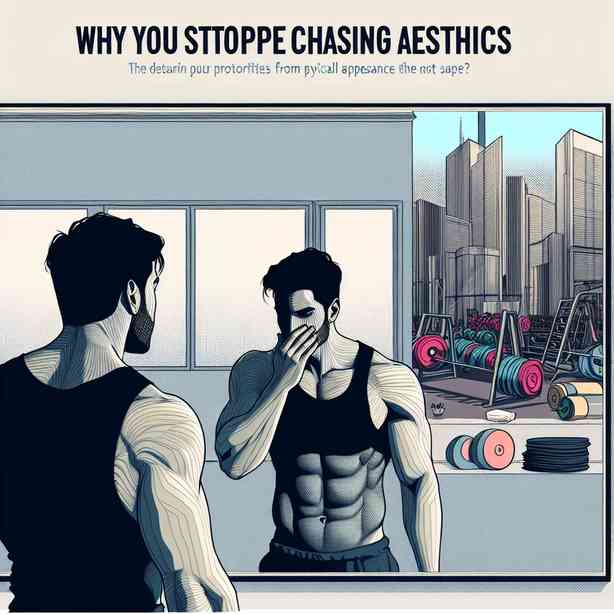
Chasing aesthetics has long been a pursuit for many, involving a deep-rooted desire to attain beauty, balance, and visual appeal in various aspects of life, from personal appearance to home decor and even in social interactions. However, there comes a point in many people’s lives when they begin to question the value of this pursuit. In this exploration, we will dissect the reasons behind the decision to stop chasing aesthetics and how that decision can lead to a more fulfilling and authentic life.
One key reason many individuals find themselves stepping back from an obsession with aesthetics is the realization that true beauty often lies in authenticity and meaning rather than superficial visuals. In a world inundated with perfect images and idealized lifestyles, it’s easy to fall into the trap of believing that external appearances define one’s worth. This perspective can lead to frustration and dissatisfaction, as no one can consistently maintain an aesthetic ideal. As one becomes more attuned to the importance of genuine connections and self-acceptance, the need to chase external beauty fades.
Moreover, the constant pursuit of aesthetics often requires considerable emotional and financial investment. Time spent curating a flawless image or maintaining perfect surroundings can detract from more meaningful experiences. People may find themselves spending hours on social media, perpetuating the cycle of comparison and envy—a behavior that ultimately leads to burnout and a sense of inadequacy. When individuals shift their focus from appearance to personal growth or community involvement, they often discover that these pursuits yield more substantial fulfillment and happiness.
Another important aspect to consider is the growing awareness of how societal standards of beauty are predominantly constructed and often unrealistic. Media representations can create an unattainable benchmark that leaves many feeling inadequate. These standards frequently promote a narrow definition of beauty, ignoring the myriad forms that beauty can take. By choosing to move away from these imposed ideals, individuals can embrace their uniqueness, fostering a healthier self-image and encouraging others to do the same. This shift can empower a community that values diversity over uniformity.
Additionally, there has been a significant cultural move towards minimalism and sustainability, which encourages individuals to prioritize quality and functionality over mere aesthetics. This trend promotes conscious consumption, where people think critically about the items they acquire and the impact of their choices on the environment. Such an approach advocates for a lifestyle that values intentional living, focusing on experiences, relationships, and personal development rather than the constant need to possess more or look a certain way. Engaging with this philosophy can be incredibly liberating as it cultivates a sense of purpose and fulfillment.
Furthermore, the exploration of one’s internal landscape becomes increasingly important as one ages. Life experiences, relationships, and personal challenges invariably shape individual identities far more than appearance ever could. Through introspection, individuals can uncover passions, values, and skills that enrich their existence. When people stop valuing aesthetics above all else, they often find a deeper appreciation for knowledge, wisdom, and emotional intelligence. This journey toward self-discovery can significantly enhance overall life satisfaction.
Communal and social values also play a pivotal role in the decision to abandon the chase for aesthetics. In many cultures, there is a growing movement towards acceptance, body positivity, and inclusivity. These values challenge the conventional norms that place undue emphasis on appearance. Celebrating individuality and encouraging authentic self-expression cultivates environments where people feel safe to be themselves. The recognition that every person has a unique story adds depth and richness to human experience, further diminishing the previous hold aesthetics may have had on individuals.
As we delve deeper into the implications of stepping back from aesthetic pursuits, it’s essential to address the psychological impacts as well. Research shows that the relentless pursuit of aesthetic ideals can lead to conditions such as anxiety, depression, and low self-esteem. Re-defining one’s self-worth away from physical looks can serve as a significant mental health boost. Individuals often experience relief and a newfound sense of freedom, as they release the burden of maintaining appearances and can now focus on self-care and personal well-being.
The journey of stepping away from aesthetics and choosing authenticity is not without its challenges. It requires courage and resilience, as societal pressures to conform can be strong. However, by surrounding oneself with positive influences—friends, family, or communities that prioritize inner qualities over outer appearances—individuals can cultivate an environment that supports their new lifestyle. Engaging in conversations and sharing experiences with like-minded individuals fosters a sense of belonging that further enhances personal growth.
In conclusion, the choice to stop chasing aesthetics could stem from a variety of deeply personal reasons, from seeking authenticity to prioritizing mental well-being. This path is often accompanied by profound self-discovery and a shift in values towards a more meaningful and fulfilling life. Embracing this journey not only enriches one’s individual experience but also contributes positively to broader societal shifts, promoting acceptance, diversity, and self-love. The moment one decides to appreciate life beyond its visual appeal, a world of deeper connections and true beauty unfolds, inviting every individual to explore their unique path towards fulfillment.


